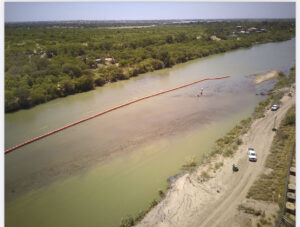Court Orders Texas To Remove Floating Death Trap From The Middle Of The Rio Grande
For the ‘law and order’ party, they don't seem all that interested in ‘law.’

Exhibit 2
Yesterday a federal judge slapped down Texas, ordering it to remove a floating barrier in the middle of the Rio Grande meant to exclude migrants from the US.
It started back in March, when Texas Governor Greg Abbott announced “Operation Lone Star,” Texas’s plan to “secure the border” from hordes of supposedly dangerous migrants bearing deadly drugs.

Diving Into Generative AI: A Practical Guide For Law Firms Starting From Scratch
“We aren’t asking for permission. Instead we are doing the federal government’s job to secure the border,” he crowed, dispatching the National Guard to slap up concertina wire on federal land. Not content with the spectacle of desperate families being pushed back into the water and a 19-year-old woman caught in razor wire and miscarrying her child during the sweltering heat, Abbott proceeded to drop a system of giant orange buoys, separated by circular saws and secured by concrete anchors in the middle of the Rio Grande.
He even had the nerve to claim that blocking the river at a hazardous crossing spot was to ensure migrant safety, even as migrants began drowning around Abbott’s floating border wall.
In July, the Biden administration filed suit in the Western District of Texas alleging that the barrier violates the Rivers and Harbors Appropriation Act of 1899 (RHA), which vests the federal government with authority over barriers placed in navigable waters. Texas countered that its barrier system was not, in fact, a barrier; that the Rio Grande is not navigable; and that its actions were justified because it was being invaded by a horde of dangerous migrants. (In fact, migrant crossings between points of entry are down significantly since asylum rules were tightened in June with the end of the COVID emergency.)
Sponsored

Why Do AI And Legal Professionals Make The Perfect Partnership?


AI’s Impact On Law Firms Of Every Size


Diving Into Generative AI: A Practical Guide For Law Firms Starting From Scratch

AI’s Impact On Law Firms Of Every Size

Not to be outdone, Abbott’s Republican allies in the US Congress joined in an amicus brief positing that navigability is really a subjective construct, and “if one takes the Book of Genesis literally, then the entire world was once navigable by boats large enough to carry significant amounts of livestock.”
But as Judge David Ezra notes, that’s not actually how the law goes. See 33 C.F.R § 329, for more clarity:
Navigable waters of the United States are those waters that are subject to the ebb and flow of the tide and/or are presently used, or have been used in the past, or may be susceptible for use to transport interstate or foreign commence. A determination of navigability, once made, applies laterally over the entire surface of the waterbody, and is not extinguished by later actions or events which impede or destroy navigable capacity.
Judge Ezra cites unambiguous Supreme Court precedent for the longstanding principle that navigability does not magically disappear at low tide, or indeed, if the body of water is affected by damming or climate change.
“The natural fluctuations in water level only momentarily impact navigability de facto, never de jure. Navigability, once granted, can only be revoked by Congress,” he writes.
Sponsored

Gain An Instant Understanding Of New Complaints With LexisNexis Snapshot

Law Firms Now Have A Choice In Their Document Comparison Software
And, furthermore, the court observes that photographs of Texas officials using airboats and a barge to construct the disputed structure would rather strongly suggest that the river can be navigated today.
As for the state’s claims that its floating roadblock is not a barrier, the court notes that it’s moored by 143 anchors weighing at least 1,000 lbs, and sports a fetching two-foot skirt of anti-dive netting. And even with all of that, it drifted into Mexican waters almost immediately and had to be repositioned. (Or perhaps it was never in American waters to begin with.)
As for the state’s claim that it is somehow at war with Central American migrants, Judge Ezra observes that this a non-justiciable political question. But the natural extension of Texas’s reasoning would be to grant the state “plenary power” which could be invoked simply by labeling another country’s actions an act of war.
“Under this logic, once Texas decides, in its sole discretion, that it has been invaded, it is subject to no oversight of its ‘chosen means of waging war,’” he writes. “Such a claim is breathtaking.”
In the end, the court ordered the state to remove the barriers and put them close to shore, restoring navigability to the Rio Grande.
“Governor Abbott announced that he was not ‘asking for permission’ for Operation Lone Star, the anti-immigration program under which Texas constructed the floating barrier,” the court wrote. “Unfortunately for Texas, permission is exactly what federal law requires before installing obstructions in the nation’s navigable waters.”
The state has already noticed its appeal to the Fifth Circuit, which, depending on the panel, may well decide that Biblical water law prevails.
US v. Abbott [Docket via Court Listener]
Liz Dye lives in Baltimore where she writes about law and politics and appears on the Opening Arguments podcast.







